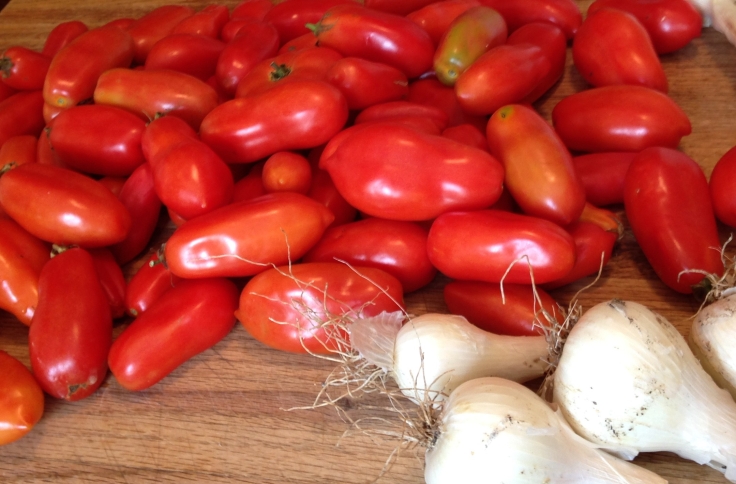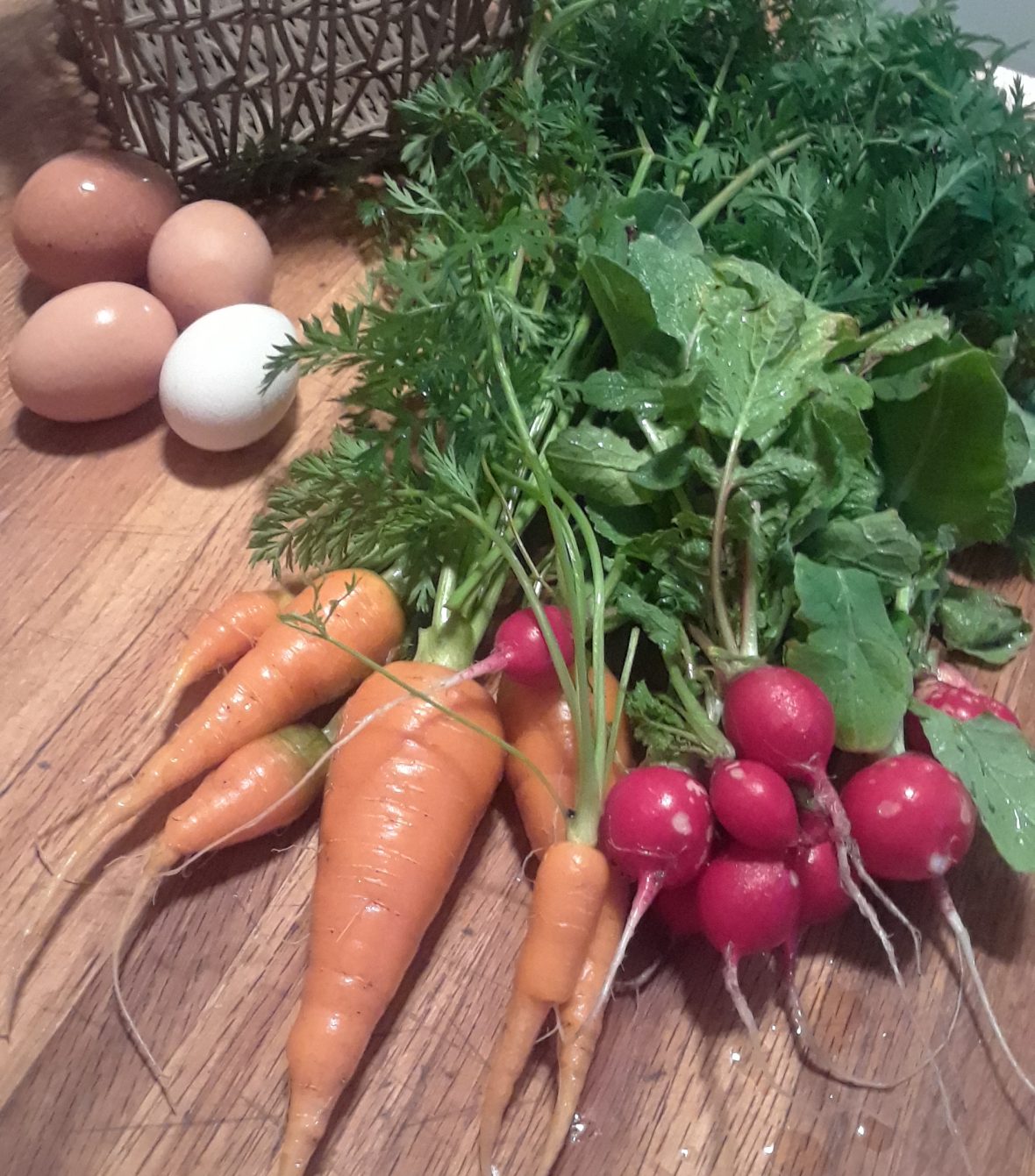When I started writing this Backyard Gardening Economics post, I knew I would have a difficult time narrowing down my topics. There are many money savers that I want to praise. There are also plenty of crops that I choose to grow for other reasons, even though I know I’m not saving money by doing so. I am trying to plan more cost efficient gardens and increase total crop yields. But, I will always make room for flavor and specialty crops.
Tomatoes: Grow for the $$$$$$$
Tomatoes are the glorious queens of the nightshade family that deserve plenty of space in every backyard garden. Home grown tomatoes are probably the current #1 money saving plant for our home. Fresh tomatoes at the grocery store are insanely expensive and rarely great quality. Tomatoes from the backyard are what we miss the most in Winter. Their flavor is far better than even heirloon varieties sold in the store.
Tomatoes are not always easy crops to grow, but the rewards are worth the efforts required. When figuring the cost of growing tomatoes I would estimate $2.00 cost per plant for organic fungicide and insecticidal soap. In other regions that may not be the case, but in Alabama we have to protect out tomatoes and sometimes hand pick gigantic horn worms the size of dachshunds. With the going rate for organic tomatoes around $3.99 per pound, I’m willing to fight any fungus, insect, or garden monster to protect my juicy crop.
To maximize tomato yields, I plant indeterminate varieties for fresh eating and determinate varieties for canning. There are tomatoes bred specifically for different climates, culinary purposes, colors, and disease resistances. So, researching tomato varieties can be daunting. My favorite high yielding varieties are San Marzano and Amish Paste for canning, Black Cherry Tomato for snacks and salads and Celebrity for overall production. I also provide space for many finicky, fungus and crack prone varieties as well. The more demanding varieties are usually the ones with the greatest flavors, deeming them worthy of garden space.

Eating our tomatoes fresh is fabulous, but our serious savings from tomatoes comes all year long. When I think of money saving crops, I think of all the jars we fill every year with marinara, salsa, and tomato based soups. We rarely purchase salsa or marinara. We just pull a home canned jar and enjoy better quality food at a fraction of the cost of store bought.
Give tomatoes plenty of room in your gardens and if you grow too many, can them. If you don’t know how to can tomatoes, check back here in July and you will find plenty of recipes and tutorials.
Peanuts: Grow for kicks and health
Since deciding to install a peanut patch in my front yard, I have been laughed at, questioned and told, “You can’t grow peanuts in your yard! You need acres!” Well, you can in fact grow peanuts in your own small plots, patio containers, or raised beds. You just might not save money growing them.
Peanuts are long season crops, requiring 120-160 days of warm weather. The plants average 36″ in diameter, a large area to lend to a single plant that will only produce 25-50 pods.
These space hogging goobers are definitely not a smart economical crop for the home garden, but there are still plenty of great excuses to grow them. They are fun and interesting crops. The lifecycle of the peanut is interesting, and growing them can be fun and educational for kids and adults.
I always try to feed my family organic produce. But, I haven’t been able to find organic raw peanuts and my oldest child’s favorite snack is boiled peanuts. So I have gladly devoted a large patch of precious garden space to this impractical crop. I’m sure the cost of soil amendments, bed preparation, high priced specialty seeds and organic fertilizer will add up to a ridiculous amount of money. By the time I harvest them, these peanuts will probably have costed me twice as much as readily available conventionally grown varieties. I don’t care. I will boil them, freeze them, and proudly stock my freezer with those organic golden goobers.

Yard Long Beans: Grow for $$$$$$
Yard Long beans(Vigna unguiculata sesquipedalis) have many names: asparagus beans, Chinese long beans, noodle beans, snake beans, bodi, and pea beans. They are a unique member of the cow pea family that are enjoyed whole like green beans.
Yard long beans are fabulous grilled, roasted, sautéed, or used in casseroles. Their flavor is similar to asparagus, and their texture is like green beans. They are well-known in Asian cooking, but should not be limited to just Asian cuisine. They are a common weeknight side dish in our household and are probably my favorite green summer vegetable.
For the last two summers I have grown yard long beans on trellises in 2 large pots. The yield from these two pots has been incredible. Most of the summer, we enjoyed these delicious beans at least two times each week. I grow them now from seeds that I save, so the only real cost for growing them is watering and a small bit of fertilizer. Their vertical growth, small space requirements, and super productivity make these an amazing money saving crop.
Six square feet filled with 14 long bean vines produced at least 24 delicious green sides (3-4 servings) for our family meals. Total value $95.76 worth of food from no more than $15.00 total investment in growing cost. This estimate of growing cost is including cost for purchasing ladybugs to control aphids because they love long beans as much as we do. The first year I grew them, I sprayed my long beans with insecticidal soap regularly; the second year, I just released ladybugs, and they seem to work even better than the insecticidal soap. Aphid control is a small price to pay for this delicious high yielding crop.
Fruit trees and berry bushes; Grow for $$$$$$$$$$$$$$$$$$$
One of the greatest long term investments you could make in your landscape is a home orchard. If you are planning on living in your home for more than 5 years, plant fruit trees. If you are living in a temporary home or an apartment; plant fruit trees on public lands or in the backyards of your friends’ homes. Find a place somewhere; dig, plant, and grow fruit!
Fruit trees, berry bushes, and fruiting vines are long living, high yielding crops that can produce decades of high value food. The return on investment of some fruits is mind-blowing. A 2-year-old quality Fuyu persimmon tree cost $59 which seems like a pretty high price for a fruit tree. However, one Fuyu persimmon tree can produce over 300 pounds of fruit in a single year with an average of 7 years of optimal production. The Fuyu persimmons sell for $3 per pound; so, in its lifespan that $59 tree could easily produce fruit worth $6300!
You could also go out and purchase an apple tree for $39 and never get a single fruit because they are not self pollinating. I will not attempt to explain fruit pollination in this post; just know, pollination is the key to fruit growing success.
Before planting fruit trees or bushes, thoroughly research the varieties you are considering. Some retailers stock fruit trees that will not thrive in the area where they are being sold. Many factors determine which fruit varieties will thrive in your area; cold hours, disease resistance, and soil acidity are a few. Take the time to learn about growing fruit prior to planting. You will be rewarded with years of big fruit harvests.

Planting the super productive, money saving crops listed here could help lower your grocery bills, substantially. Make the most of your entire yard by making room for fruits, vegetables, and herbs everywhere possible. Why not landscape with edible pear trees? Plant hedges of rosemary? Your plantings will save you money most of the time. But, when the cost of growing makes a crop impractical, you can find plenty of other great reasons to grow it. Lawns and ornamental plants will never feed you or save you money, so grow more food!






Oh man, what a great pair of articles! I really appreciated how you noted the crops you grow to save money vs the crops you grow because of quality and flavor – something I am very much aware of with my own garden. I’m glad carrots made your list – I successfully grew them for the first time last year and was so disappointed when I had to go back to bland store carrots. Yes, they’re cheap to buy, but the fun and satisfaction I get when harvesting my own carrots, not to mention the flavor difference, definitely adds value in my mind!
LikeLike
We just ate the last of our spring carrots. And I am so sad that they are all gone. Grocery store carrots are so bland.
LikeLike